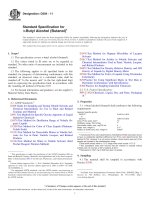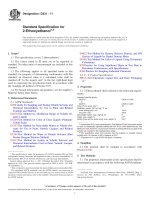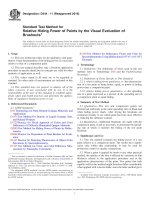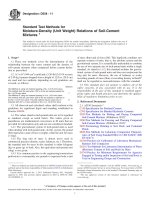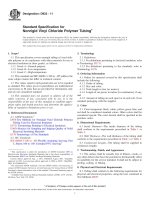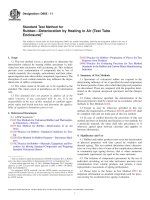Astm d 4942 11
Bạn đang xem bản rút gọn của tài liệu. Xem và tải ngay bản đầy đủ của tài liệu tại đây (78.11 KB, 4 trang )
Designation: D4942 − 11
Standard Test Methods for
Water Pickup of Lithographic Printing Inks and Vehicles in a
Laboratory Mixer1
This standard is issued under the fixed designation D4942; the number immediately following the designation indicates the year of
original adoption or, in the case of revision, the year of last revision. A number in parentheses indicates the year of last reapproval. A
superscript epsilon (´) indicates an editorial change since the last revision or reapproval.
under laboratory conditions. Test results may be useful for
specification acceptance between the supplier and the customer.
1. Scope*
1.1 These test methods cover two procedures for determining the amount of water picked up by lithographic printing inks
in a laboratory mixer.
3.2 In order that results be comparable, the tests must be run
at the same temperature and with the same type and quantity of
liquid added prior to mixing.
1.2 Test Method A covers single-point water pickup; Test
Method B covers the rate of water pickup. Both test methods
are applicable to any printing ink and vehicle intended for the
lithographic printing process.
3.3 The emulsions obtained in these test methods are of
larger particle size than those typically produced in printing
nips. Because of these and other variables in the printing
process, water pickup results do not by themselves predict
lithographic printing performance.
1.3 The values stated in SI units are to be regarded as
standard. No other units of measurement are included in this
standard.
1.4 This standard does not purport to address all of the
safety concerns, if any, associated with its use. It is the
responsibility of the user of this standard to establish appropriate safety and health practices and determine the applicability of regulatory limitations prior to use.
4. Apparatus
4.1 Laboratory Mixer, equipped with a stainless steel specimen bowl 83 mm wide and 88 mm high, mixer blades that
rotate at 90 r/min, and a timing device.
4.2 Balance, accurate to 0.1 g, 600-g capacity.
2. Summary of Test Methods
4.3 Palette knives, two.
2.1 These test methods utilize a laboratory mixer for beating
water or other agreed upon fluid into the test ink.
4.4 Thermometer, quick response.
4.5 pH Meter (optional).
2.2 For single-point water pickup (Test Method A), 50 mL
of water is normally added to 50 g of ink and mixed in for 5
min. The water picked up is determined from volumetric
measurements of free water.
4.6 Conductivity Meter (optional).
4.7 Graduated Cylinder, 50 or 100-mL.
5. Reagents and Materials
2.3 For rate of water pickup (Test Method B), water is added
to 50 g of ink in increments of 20 mL and mixed in for 1 min
or more over a cumulative time period totaling 10 min. The
water taken up by the ink after each mixing interval is
determined gravimetrically.
5.1 Water—Deionized or distilled water, preferably having a
pH of 5.0 to 7.0 (100 to 200 mL per sample); alternatively,
fountain solution or other aqueous medium as agreed upon
between the supplier and the customer may be used.
5.2 Cleanup Materials—Naptha and rags or tissues.
3. Significance and Use
3.1 The lithographic printing process requires that some
dampening solution be emulsified into the ink. These test
methods provide a rapid means for determining water pickup
6. Test Specimen
6.1 A minimum of 100 g is sufficient for two determinations. Before removing ink from the can, stir or otherwise
ensure that the ink specimen is representative. Close the can
and replace sealing tape immediately after each ink removal.
1
These test methods are under the jurisdiction of ASTM Committee D01 on
Paint and Related Coatings, Materials, and Applications and are the direct
responsibility of Subcommittee D01.56 on Printing Inks.
Current edition approved June 1, 2011. Published June 2011. Originally
approved in 1989. Last previous edition approved in 2006 as D4942 - 89 (2006).
DOI: 10.1520/D4942-11.
7. Conditioning
7.1 Condition the instrument, water, and ink samples in a
constant temperature room or bath, preferably at 23 6 1°C.
*A Summary of Changes section appears at the end of this standard
Copyright © ASTM International, 100 Barr Harbor Drive, PO Box C700, West Conshohocken, PA 19428-2959. United States
1
D4942 − 11
8.12 Repeat 8.3 through 8.10 with a second specimen of the
same ink.
7.2 Prior to use, check the alignment of the mixer blades.
With the power switch of the mixer in the off position, set the
clean bowl into the turntable and engage the locking pin firmly
into the slot in the side of the turntable. Tilt the mixer head
back and insert the blades, marked left and right, into their
respective holders. Lower the mixer head. If the blades hit the
side or bottom of the bowl, return the instrument to the
manufacturer for realignment.
9. Test Method B—Rate of Water Pickup (by
Gravimetry)
9.1 Program the counter for the first interval of the mixing
cycle.
NOTE 3—A commonly used cycle is 1-min intervals (90 revolutions)
times ten determinations. Intervals need not be uniform, for example, 1, 2,
3, 5, and 10 min (90 times 3 plus 180 plus 450 revolutions).
8. Test Method A—Single Point Water Pickup (by
Volumetry)
9.2 Optional—Measure water properties in accordance with
8.2.
8.1 Program the counter of the mixer for 5 min mixing time
(450 revolutions).
9.3 Weigh or tare the clean dry mixing bowl and blades on
the balance. Add 50 6 0.1 g of ink to the center of the bowl.
8.2 Optional—If the first run of the day, pour test water into
a beaker. Measure pH, conductivity, and temperature at the
beginning of testing.
9.4 Lock the bowl on the platform of the mixer. With the
mixer head raised, carefully insert the blades into their respective holders. If ink on one blade touches the upper parts of the
other blade or the side of the bowl, carefully remove the ink
with two palette knives and transfer to the bottom of the bowl.
Lower the mixer head.
8.3 Weigh or tare the clean dry mixing bowl. Add 50 6 0.1
g of the ink to the center of the bowl.
8.4 Pour 50 mL of water (from 8.2) into a graduated
cylinder. If the ink is expected to pick up more than 100 %
water, use 100 mL of water. Adjust the volume to 60.5 mL.
Add the entire contents to the bowl.
9.5 Pour 100 mL of water (from 8.2) into a beaker. Meter
out 20 mL and add to the bowl.
8.5 With the mixer head tilted back insert the clean blades,
marked left and right, into their respective holders. Lock the
bowl on the turntable. Lower the mixer head. Press the counter
reset button, making sure that 450 is displayed on the face of
the counter.
9.6 Press the counter reset button, making sure that the
desired number of revolutions is displayed on the face of the
counter. Turn the mixer on. Examine the contents of the bowl
as mixing progresses. If all liquid disappears into the ink, add
more as needed to maintain a layer of excess water on the
surface of the ink.
8.6 Turn the mixer on. Examine contents of the bowl as
mixing progresses. If 50 mL of water had been added and all
of it disappears into the ink, stop, discard the ink in the bowl,
clean up, and start over from 8.3, adding 100 mL of water in
8.4. The latter quantity must also be used for all other inks in
the series under study.
NOTE 4—Few specimens will take up more than 20 mL of water within
a 1-min mixing interval. If a high-water pickup specimen is being run and
the mixing interval is longer than 1 min, another 20 mL should be added
prior to each subsequent minute of mixing time.
9.7 When the mixer stops, turn the power switch off. Detach
the mixing blades and add to the bowl.
NOTE 1—With some inks, water pickup is affected by the amount of
water added prior to mixing. When 50 mL is insufficient, do not simply
add another 50 mL during the run, as test results may differ significantly
from those obtained by adding 100 mL at the outset.
9.8 Remove the bowl from the turntable and, holding the
blades at the side of the bowl, decant the free water into the
beaker containing the unused water. Run the blades very slowly
through the ink in the bowl. Decant additional free water into
the beaker (see Note 2).
8.7 When the mixer stops, turn the power switch off. Tilt the
head out of the ink, detach the mixing blades, and add to the
bowl.
9.9 Weigh the mixing bowl and contents, including the
blades.
8.8 Remove the bowl from the turntable and, holding the
blades at the side of the bowl, decant the free water into a
graduated cylinder. Run the blades very slowly through the ink
in the bowl. Decant additional free water into the cylinder.
9.10 Using a palette knife, transfer the ink from the walls to
the center of the bowl. Return the bowl to the mixer. Replace
the blades as in 8.4.
NOTE 2—Do not knock the bowl to force free water from the surface.
Always handle the bowl gently to avoid breaking the emulsion.
9.11 For the next mixing interval, swirl the beaker in order
to mix the returned and unused water. Meter out 20 mL and add
to the bowl. Press the counter reset (or change the counter) and
turn the power on. Add more water if needed to maintain an
excess layer (see Note 4).
8.9 Record the returned water level to 0.5 mL.
8.10 Optional—Measure the temperature, pH, and conductivity of the returned water. Note the appearance of the water
and the consistency of the ink and the appearance of the
returned water.
9.12 When the mixer stops, repeat 9.7 through 9.11 until the
cumulative mixing time totals at least 10 min.
8.11 Discard ink left in the bowl. Clean the bowl and the
mixer blades with tissue wetted with naphtha. Discard the
returned water and rinse the cylinder clean.
9.13 Optional—At the end of the run, make measurements
in accordance with 8.10.
2
D4942 − 11
on each of two days three lithographic printing inks ranging in
5-min water pickup from 50 to 65 %. One company was found
to be an outlier and was deleted from the analysis. The within
laboratory pooled standard deviation was found to be 1.58 %
absolute (millilitre of water per 100 grams of ink) at 9 degrees
of freedom (df), and the between laboratories pooled standard
deviation was 7.1 % absolute at 30 df. Based on these standard
deviations, the following criteria should be used for judging the
acceptability of results at the 95 % confidence level:
12.1.1.1 Repeatability—Two results, each the mean of two
runs obtained by one operator, should be considered suspect if
they differ by more than 4.5 % absolute.
12.1.1.2 Reproducibility—Two results, each the mean of
two runs obtained by operators in different laboratories, should
be considered suspect if they differ by more than 20 %
absolute.
12.1.2 Test Method B—In an interlaboratory study of rate of
water pickup by Test Method B, water pickup values at 21⁄2, 5,
71⁄2 and 10 min were determined twice on one day by one
operator in each of nine laboratories on six inks. The inks
ranged in water pickup from 40 to 52 % at 21⁄2 min and from
65 to 100 % at 10 min. After rejecting 12 out of 156 replicated
test values as outliers, the within laboratory pooled standard
deviation was found to be 1.58 % absolute (grams of water per
100 grams ink) with 97 df and the between laboratory standard
deviation 3.73 % absolute with 86 df. Based on these standard
deviations, the following criteria should be used for judging the
acceptability of results at the 95 % confidence level:
12.1.2.1 Repeatability—Repeatability cannot be determined
as both runs were conducted on the same day.
12.1.2.2 Reproducibility—Two water pickup curves, each
the mean of two runs, obtained by operators in different
laboratories should be considered suspect if they differ by more
than 10.5 % absolute.
9.14 Discard the ink left in the bowl. Clean the bowl and the
mixer blades with tissue wetted with naphtha. Discard returned
water and rinse the beaker clean.
9.15 Repeat 9.3 through 9.14 with another specimen of the
same ink.
10. Calculation
10.1 Calculate water pickup, P, as follows:
10.1.1 Test Method A—Volumetric :
P 5 ~ V 1 2 V 2! 3 2
(1)
where:
P = water pickup, % or mL water/100 g ink,
V1 = volume of water added, mL, and
V2 = volume of returned water, mL.
10.1.2 Test Method B—Gravimetric :
P 5 ~W 2 S! 3 2
(2)
where:
P = water pickup, % or g water/100 g ink,
W = weight of the specimen plus water picked up after each
mixing interval, g, and
S = weight of initial specimen, g.
NOTE 5—The conversion from water pickup of the ink to water content,
C, of the emulsion is C = P/(100 + P). Units are percent or grams of water
per 100 grams of emulsion.
11. Report
11.1 Report the following information:
11.1.1 The percent water pickup to the nearest whole
number as the mean of the two determinations, the cumulative
mixing time, and a description of the water used for testing (for
example, tap water, deionized water, or type of fountain
solution).
11.1.2 If rate of water pickup was determined, plot the
percent of water pickup versus the cumulative mixing time.
11.1.3 Optional—The mean temperature, changes in pH,
conductivity, appearance of the water, and the change in
consistency of the ink.
12.2 Bias—Bias cannot be determined because there are no
standard materials. The poorer interlaboratory precision of Test
Method A compared to Test Method B is believed to be caused
by the fact that the gross quantity of water added at one time
is picked up as large globules which make it difficult for
different operators to release free water in the same manner.
12. Precision and Bias
13. Keywords
12.1 Precision:
12.1.1 Test Method A—An interlaboratory study of singlepoint water pickup by Test Method A was conducted in which
one operator in each of eleven laboratories tested in duplicate
13.1 emulsification; fountain solution; inks; lithographic
printing inks; mixers ; printing inks; vehicles; water content;
water pickup
3
D4942 − 11
SUMMARY OF CHANGES
Committee D01 has identified the location of selected changes to this standard since the last issue
(D4942 - 89 (2006)) that may impact the use of this standard. (Approved June 1, 2011.)
(1) Removal of references to a specific source of apparatus
supply in 4.1.
(2) Summary of Changes added.
ASTM International takes no position respecting the validity of any patent rights asserted in connection with any item mentioned
in this standard. Users of this standard are expressly advised that determination of the validity of any such patent rights, and the risk
of infringement of such rights, are entirely their own responsibility.
This standard is subject to revision at any time by the responsible technical committee and must be reviewed every five years and
if not revised, either reapproved or withdrawn. Your comments are invited either for revision of this standard or for additional standards
and should be addressed to ASTM International Headquarters. Your comments will receive careful consideration at a meeting of the
responsible technical committee, which you may attend. If you feel that your comments have not received a fair hearing you should
make your views known to the ASTM Committee on Standards, at the address shown below.
This standard is copyrighted by ASTM International, 100 Barr Harbor Drive, PO Box C700, West Conshohocken, PA 19428-2959,
United States. Individual reprints (single or multiple copies) of this standard may be obtained by contacting ASTM at the above
address or at 610-832-9585 (phone), 610-832-9555 (fax), or (e-mail); or through the ASTM website
(www.astm.org). Permission rights to photocopy the standard may also be secured from the ASTM website (www.astm.org/
COPYRIGHT/).
4

